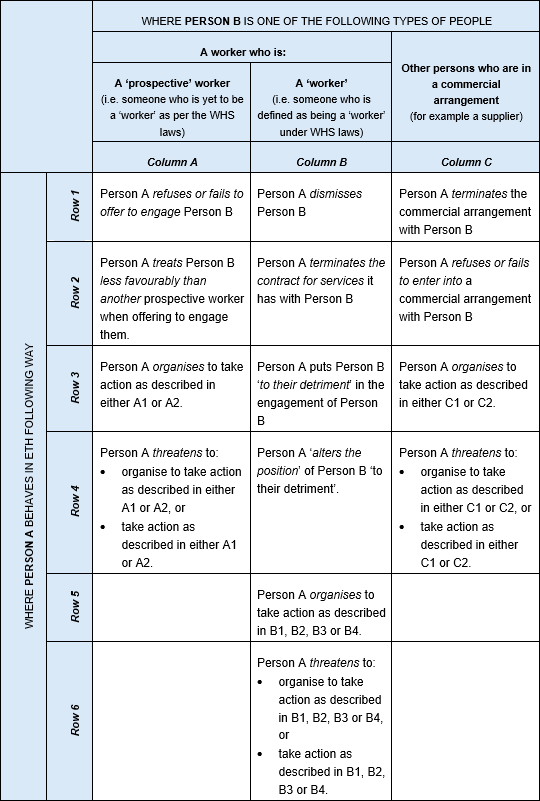Direct Discriminatory Conduct
The WHS Act state that a person must not engage in discriminatory conduct where the reason for engaging in that conduct is a prohibited reason.
The easiest way to understand how the WHS laws apply here is that:
The Behaviour + The Reason = The Penalty
The Behaviour
The WHS Act applies to a number of different types of discriminatory behaviour, depending on who is on the receiving end of that behaviour.
The different types of behaviours and groups of people are set out in Table 1.
To make it easier to understand, we will
call:
the person engaging in the behaviour as ‘Person A’
the person on the receiving end of this behaviour as ‘Person B’.
classify each type of behaviour in terms of where it sits within the table (for example ‘Behaviour A1’ is described in column A, row 1)
Table 1
The Reason
The second requirement that needs to be met is that the reason for the behaviour is a prohibited reason.
There are three things that are important to understand. They are:
What a prohibited reason is (they are set out below).
The fact that a person only commits an offence if the reason (as described below) was the dominant reason for the behaviour.
If legal proceedings are brought against Person A and it is proved that one of the reasons for the behaviour was a prohibited reason, then it is presumed that the prohibited reason was the dominant reason. It will be up to Person A to prove otherwise.
In order for the reasons for Person A’s behaviour towards Person B to be a prohibited reason it needs to be that, in relation to:
Health & Safety Representatives (HSRs) and Health & Safety Committees (HSCs) – Person B
is,
has been or
proposes to be,
an HSR or a member of the HSC.
The powers and functions of HSRs or members of an HSC – Person B:
has exercised a power and/or performed a function,
is exercising a power and/or performing a function, or
proposes to exercise a power and/or perform a function,
of an HSR or member of an HSC.
Other roles under the WHS Act – Person B:
has undertaken,
undertakes, or
proposes to undertake,
another role under the WHS Act.
Powers under the WHS Act – Person B:
has exercised or refrained from exercising,
is exercising or is refraining from exercising, or
proposes to exercise or refrain from exercising,
the power, either:
in a particular way, or
at all.
Functions under the Act – Person B:
has performed or refrained from performing,
is performing or is refraining from performing, or
proposes to perform or refrain from performing,
the function, either:
in a particular way, or
at all.
Assistance or information – Person B:
has assisted or given information to,
is assisting or giving information to, or
proposes to assist or give information to,
any person exercising a power or performing a function under the WHS Act.
Issues or concerns about WHS - Person B:
has raised,
is raising, or
proposes to raise,
an issue or concern about WHS with:
the PCBU,
an Inspector,
a WHS entry permit holder,
an HSR,
a member of an HSC,
another worker,
any other person who owes a duty under the WHS Act with respect to the matter, or
any other person exercising a power or performing a function under the WHS Act.
Seeking compliance with the WHS Act – Person B:
has taken,
is taking, or
proposes to take
action to seek compliance by any person with any duty or obligation under the WHS Act.
Resolving a WHS issue under the WHS Act – Person B:
has been involved in,
is involved in,
proposes to be involved in,
resolving a WHS issue under the WHS Act.
If these conditions are satisfied, Person A:
not only faces the possibility of having civil proceedings brought against them, but
could have criminal proceedings brough against them.
The Maximum Penalty
For an individual – 1,206 PU (for the 2025-26 year = $148,711).
For a body corporate – 6,028 PU (for the 2025-26 year = $743,312).
Learn more in the next article: Indirect Discriminatory Conduct


